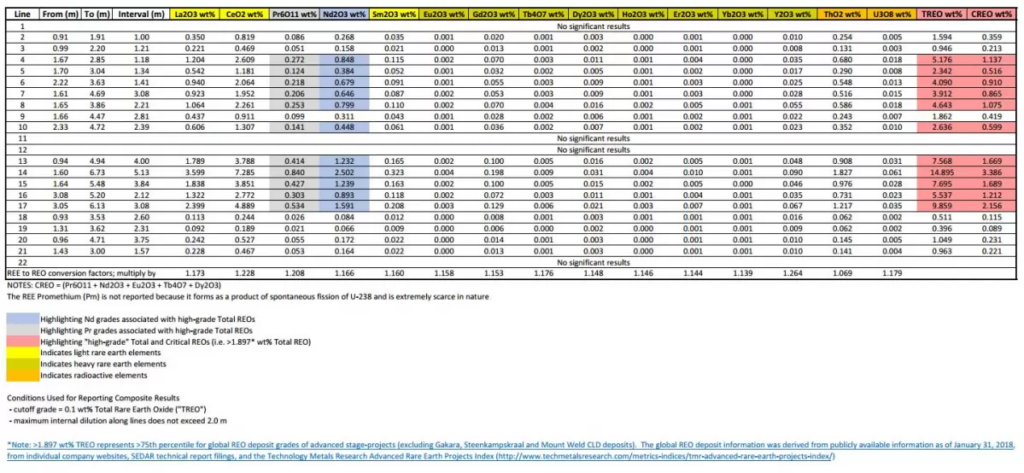Toronto, Ontario–(Newsfile Corp. – September 18, 2018) – Appia Energy Corp. (CSE: API) (OTCQB: APAAF) (FSE: A0I.F) (FSE: A0I.MU) (FSE: A0I.BE) (the “Company” or “Appia) is pleased to provide geochemical assay results from surface channel samples collected from the Charles zone as part of the on-going exploration program (the “Program“) being carried out on the Alces Lake Property (the “Property“) in northern Saskatchewan.
Surface channel sample geochemical assay results for the Charles zone are provided in Table 1. The highest results were obtained along line 14 (see Figure 1) which returned 14.90 wt% total rare earth oxides (“TREO“) over 5.1 m. Other notable results include 9.859 wt% TREO over 3.1 m from line 17, and 7.568 wt% TREO over 4.0 m from line 13. Eleven of the 18 lines (or 61%) with REO mineralization had grades considered to be “high-grade” REOs (see Table 1). A total of 22 lines were sampled, with 221 samples collected from the lines. Lines were spaced approximately 2.0 m apart.
Mr. James Sykes, Vice President of Exploration and Development for Appia comments: “The results from the Charles zone continue to highlight the high-grade rare earth element (“REE“) potential of the Property. The surface work of the Program has provided valuable geological insights that could help Appia identify areas of potential, additional subsurface rare earth oxide mineralization.”
Overburden stripping and the collection of systematic channel samples were taken from all seven exposed zones and have been hand delivered to the Saskatchewan Research Council’s (“SRC”) Geoanalytical Laboratory, an ISO/IEC 17025:2005 (CAN-P-4E) certified laboratory in Saskatoon, SK for multi-element and REE analysis using the Whole—Rock and Rare Earth Element Lab Packages. The Rare Earth Element analysis uses a lithium metaborate fusion to dissolve refractory minerals such as monazite.
Diamond drilling into the zones is currently underway and will continue through the current month of September. The results from the analyses of all the samples collected from these zones will be reported as they become available.
The Alces Lake Property encompasses some of the highest-grade total and critical REE mineralization in the world, hosted within seven surface showings that remain open in all directions (see *Note below). Critical rare earth elements are defined here as those that are in short-supply and high-demand for use in permanent magnets and modern electronic applications (i.e: Neodymium (Nd), Praseodymium (Pr) and Dysprosium (Dy)). The Alces Lake project area is 14,334 hectares (35,420 acres) in size.
All geochemical results reported herein have passed rigorous internal QAQC review and compilation.The technical content in this news release was reviewed and approved by Thomas Skimming, P.Eng, a Director of Appia, and a Qualified Person as defined by National Instrument 43-101.
*Note: The Alces Lake REE grades were compared with global REE deposit grades. The global REE deposit information was derived from publicly available information as of January 31, 2018, from individual company websites, SEDAR technical report filings, and the Technology Metals Research Advanced Rare Earth Projects Index (Click Here).
About Appia
Appia is a Canadian publicly-traded company in the uranium and rare earth element sectors. The Company is currently focusing on delineating high-grade critical rare earth elements (“REE”) and uranium on the Alces Lake property, as well as prospecting for high-grade uranium in the prolific Athabasca Basin on its Loranger, North Wollaston and Eastside, properties. The Company holds 100% of the surface rights to exploration over 63,980 hectares (158,098 acres) in Saskatchewan.
The Company also has NI 43-101 compliant resources of 8.0 M lbs U3O8 and 47.7 M lbs Total REE Indicated and 20.1 M lbs U3O8 and 133.2 M lbs Total REE Inferred in the Teasdale Zone plus 27.6 M lbs U3O8 Inferred in the Banana Lake Zone in the historic mining camp of Elliot Lake in Ontario (previously reported in the Company’s news release dated August 14, 2013). The resources are largely unconstrained along strike and down dip.
Appia’s technical team is directed by James Sykes, who has had direct and indirect involvement with over 450 M lbs. U3O8 being discovered in five deposits in the Athabasca Basin.
Appia currently has 58.4 million common shares outstanding, 76.6 million shares fully diluted.
Cautionary Note Regarding Forward-Looking Statements: This News Release contains forward-looking statements which are typically preceded by, followed by or including the words “believes”, “expects”, “anticipates”, “estimates”, “intends”, “plans” or similar expressions. Forward-looking statements are not guarantees of future performance as they involve risks, uncertainties and assumptions. We do not intend and do not assume any obligation to update these forward- looking statements and shareholders are cautioned not to put undue reliance on such statements.
Neither the Canadian Securities Exchange nor its Market Regulator (as that term is defined in the policies of the CSE) accepts responsibility for the adequacy or accuracy of this release.
For further information, please contact:
Tom Drivas, President, CEO and Director: (tel) 416-546-2707, (fax) 416-218-9772 or (email) appia@appiaenergy.ca
James Sykes, VP Exploration & Development, (tel) 306-221-8717, (fax) 416-218-9772 or (email) jsykes@uraniumgeologist.com
Frank van de Water, Chief Financial Officer and Director, (tel) 416-546-2707, (fax) 416-218-9772 or (email) fvandewater@rogers.com

Figure 1: REE surface mineralization exposed at Charles zone. Mineralization is displayed as >0.1 wt% TREO

*Note: >1.897 wt% TREO represents >75th percentile for global REO deposit grades of advanced stage-projects (excluding Gakara, Steenkampskraal and Mount Weld CLD deposits). The global REO deposit information was derived from publicly available information as of January 31, 2018,from individual company websites, SEDAR technical report filings, and the Technology Metals Research Advanced Rare Earth Projects Index (Click Here)
Table 1: Results for the Charles zone




